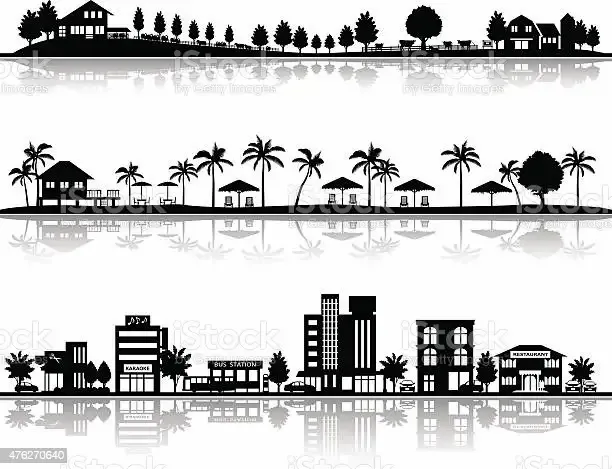
Population refers to the number of people living in a specific geographical area at a specific time.
Definition of Census
Census is the generally the official counting of a country's people with information as to age, sex, occupation etc. The normal interval between one census and another is ten years. This is because it is expected
or assumed that within ten years things like the size of the population, age distribution, sexdistribution and so on might have changed. The size of population depends on:
- The Natural growth, that is the rate at which people grow.
Migration, that is the movement of people from one place to another.
The current size of Ghana's population is over 32 million.
High dependency ratio means that few people in the working population take care of many people and therefore cannot save enough money for themselves.
This will lead the government to spend a lot of financial resources (money and finances) in providing educational facilities for a very large proportion of the population that is between 6 and 16 years.
The country has a youthful population to provide a major working force in the near future. This is known as the strength of the dependency ratio.
EFFECTS OF RAPID POPULATION GROWTH ON THE FAMILY.
Some of the changes that rapid population growth has on the family includes.
Poor maternal and child health: Rapid population may make the health of the mother and the child worse with a possible increase in the incidence of maternal and infant mortality. Maternal and infant mortality refer to death of mothers and babies.
Disintegration of the family as a unit: This means the family breaks into small parts and becomes much less strong or united and may be gradually destroyed. A family which is constantly not in a position to provide adequately for its members may break up or disintegrate.
This is what may happen: Divorce could take place or the father or mother may abandon the family because the circumstance the father or mother finds himself or
herself is bad that he or she cannot deal with it. Children who are old enough in such a family may run away from home to look for help or even employment elsewhere.Also younger children in the family are likely to get ill very often or will be in bad health.
because of a lack of food or a lack of the right type of food, inadequate clothing and shelter.High dependency burden on the family: In other words, many children who must rely on the parents causes great worry, difficulty or hard work on the family.
Some of the effects of rapid population growth on the community includes.
- Dwindling capacity of local institutions to meet the needs of the growing population adequately: For example, the police are not able to meet the needs of the growing population adequately because their number, logistics and resources are far less compared
to the population of the community.
Pressure on social facilities like water, housing, schools, food, transportation, among others. A population that is growing fast would naturally require things like more schools and teachers as well as more health centres and personnel. This means that the
community or the district assembly would have to find more money to meet such demands.The average nuclear family in every village, town or city in the country has many children. These children are of school going age. Such children perhaps have only the father or mother working and so earn income or get money for work that they do. Therefore we can
say that there is a high dependency burden on the family. In other words, a very large number of people who are young and may not be working will have to depend on the very few people who are employed for all their needs, that is, the things they require in order to
live in a comfortable way or achieve what they want.
THE NATION.
The country's resources such as agricultural resources, petroleum, etc are not adequate to
meet the needs of a fast growing population.Depletion of natural resources at a very fast rate. In other words, because the country's
population is rapidly increasing, there is also pressure on natural resources which are reducing by large amount so that there is not enough left, for example timber.There is low per capita income because of the large number of people being produced Low per capita income directly leads to poverty and low standard of living. Low per capital income is the average income that each member of the Ghanaian population.
You cannot say a large family is the perfect or the most suitable . You cannot also say a small family is the perfect or suitable. So here taking the arguments for or against whether a small family or a large family is more
ideal, the more important factor than anything else in particular should be the quality of life the children are likely to enjoy and not the number of children. In other words, family size (how large or small a family is) must be looked at face-to-face with the resources the parents have and resources the nation also has. The resources that are available to both the individuals and the country must then go well together and produce an attractive result.
Some factors to consider when planning an ideal family size include.
The effect on health of the mother and child.
The effect on food supply.
The effect on education and health sectors.
The effect on standard of living.
Poor or lack of education
Early marriage of girls
Teenage pregnancy
Substance abuse
Street children
Inadequate parental care
Malnutrition
Sexually transmitted diseases (HIV / AIDS)
Ways of reducing social problems associated with a very fast growing.
population include the following:
Implementation of the National Population Policy, for example family planning and sex education
Need for proper upbringing of children so that their behaviour or actions follow the accepted rules, norms and values of the society.
Creating the awareness of the negative effects of early marriage and teenage parenthood,
Provision of adequate services to meet the ever-growing needs of children.
The need to lay special emphasis on adolescents by making the population and family life education programmes more accessible.
Increasing gender equality and giving girls the right to choose.Girls should be given equal opportunity to go to school.


Today, many people, especially the youth (young people) are moving from the rural areas to the urban areas. This movement is termed rural-urban drift. Rural-Urban drift is therefore the movement of people from
rural areas to the urban areas. Urban refers to anything that is connected with a town or city while rural suggests outside towns and cities. Rural-Urban drift is a type of migration.
Migration:
Migration is the movement of large numbers of people from one place to another. Migration may take the following forms:
Emigration: This is one way outward movement of people from a place to another.
Immigration: This is a one-way inward movement of people into a place.
Migration: It is a rhythmic (having a regular pattern of movement), periodie or seasonal inward and outward movement of people in a place.
Rural-Urban Migration (drift) as type of migration
Rural -urban migration (drift) is the movement of people from rural to urban areas often for the best economic opportunities for themselves . A person who moves from one place to another especially in for jobs, school, amenities. etc
Many Ghanaians, especially the young people (the youth) do not want to live and work in the areas (the villages and small communities). They rather move to cities and urban centres insearch of work and good life. Among the several reasons for this are the following:
- The availability of amenities and infrastructural facilities.
The rural areas do not have basic amenities like potable water, electricity, hospitals, theatre's, etc. Since the urban centres have such amenities, they attract the youth. The fact is that, poorly developed areas like the villages and small communities with little or no amenities encourage people to move out, especially the youth.
- White Collar Jobs
The youth who have acquired education want to work in offices which exist in the towns and cities.
- Land Tenure System
Land to work on is difficult to come by, especially for the youth, so they move into the urban centres for jobs for a living.
Education
A great number of the best schools are in the cities and towns. The youth therefore move to those areas in search of quality education in the best schools.Job opportunities
Because people want good life, especially the youth, they move from their villages and small communities to the urban centres where they can find suitable jobs. The work they qualify for or they prefer may be difficult to come by in the rural areas. Note that the main economic activity in the rural areas is farming.
- Trade
Lack of employment avenues or opportunities for the youth makes them resort to trading which is very lucrative. So with a little capital, they go into the business of trading. Since the towns and cities are good places where people sell or buy a lot of things and do brisk busines, they attract the youth.
- Societal pressures.
Some families in the rural areas put pressure on their wards to seek greener pastures (a better way of life) in the cities where they hope their wards could remit them. They also believe having their wards in the big towns and cities will make the community respect them or hold them in high esteem.
PROBLEMS OF RURAL URBAN-DRIFT.
The problem created by rural-urban drift should be looked at from two angles. One is, problems created in the rural areas because of movement from rural areas to urban centres and two, problems created in urban centres because of movement from rural areas into urban centres.
The Problems created by Rural-Urban Drift in RuralAreas The following are some of the problems created in the rural areas because of emigration(the one-way outward movement of people).
There is increase in the incidence of broken homes.
Lack of supervision of children resulting-in high incidence of teenage pregnancy, child delinquency and crime.
Poverty of women because of lack of support of male partners.
Loss of able-bodied population to the urban centres.
General depopulation of the rural areas.
Lack of social amenities and facilities.
Some of the problems which rural-urban drift create in the urban centres because of. immigration (the one-way in ward movement of people into a place) are:
Unemployment
Pressure on facilities like public toilet, telephone booths, etc.
Rise in crime wave, drug addiction, prostitution and other social ills.
Deterioration of environmental sanitation.
Overerowding and creation of slum. These are very clear in housing congestion and traffic congestion etc.
Insufficient and over-stretched social amenities
Street children

Measures that will prevent or control the rural youth from migrating to urban centres includes.
Providing job opportunities in the rural areas.
Appropriate land tenure system that may attract the youth to go into farming.
Making the rural areas more attractive by providing social amenities and education
facilities.Spreading development projects in both urban centres and rural areas.
Citing of factories and cottage industries in
Thank you all for your previous time.
Everybody want big cities see the way Accra is choked. Lolx my humble suggestion the capital should be moved from Accra to another region.
Downvoting a post can decrease pending rewards and make it less visible. Common reasons:
Submit
Hi @veredede!
Why do u like to always plagiarise? This is your second warning here. Try to make your writings genuine. I won't warn you again.
These are the sources you plagiarised from.
https://ebrary.net/188194/engineering/experimental_investigation_performance_array_topologies_under_simulated_pscs
https://www.oxfordlearnersdictionaries.com/us/definition/english/need_2
@juzkid
Downvoting a post can decrease pending rewards and make it less visible. Common reasons:
Submit
Please I am a bit confused because this post wasn’t taken from the internet, but rather was written from my own experience and understanding. Besides I do not see anything corresponding to my post from the link you have provided.
Dear @nattybongo why is this happening? It’s very sad
Downvoting a post can decrease pending rewards and make it less visible. Common reasons:
Submit